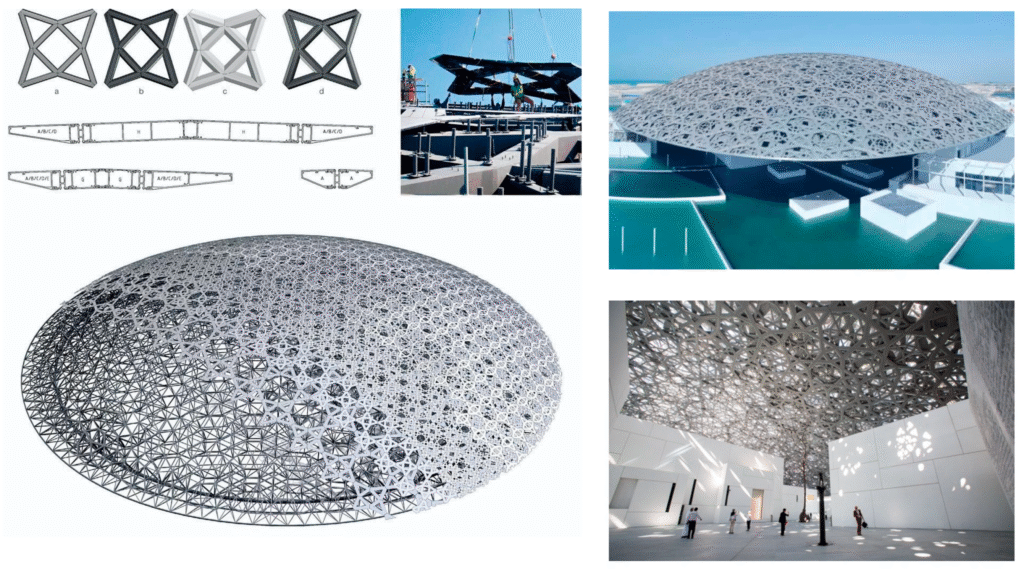Sacred Geometry is everywhere—from the spiraling galaxies in the cosmos to the petals of a flower. For centuries, civilizations across the globe have found meaning in patterns, ratios, and shapes, seeing in them more than just mathematical order—they saw the fingerprints of the divine. This concept, known as sacred geometry, is the belief that certain geometric principles and patterns form the fundamental structure of the universe and carry deep spiritual significance.
From ancient temples to modern architectural wonders, sacred geometry has served as a universal design language, guiding how humans build, decorate, and conceptualize sacred spaces. It isn’t merely about lines and angles—it is about meaning, balance, and the search for a connection between the material and the spiritual.
This article explores the origins, philosophies, and applications of sacred geometry, revealing how it continues to shape art, architecture, and design today.
1. The Origins of Sacred Geometry
The idea that geometry holds spiritual meaning dates back thousands of years. Early civilizations recognized recurring patterns in nature—spirals in shells, hexagons in honeycombs, and the symmetrical unfolding of flowers. These patterns were seen not as coincidences, but as evidence of universal order.
- Egypt and the Golden Proportion
Ancient Egyptians were among the earliest practitioners of sacred geometry. The construction of the Great Pyramid of Giza reflects precise mathematical relationships, including the golden ratio (1:1.618). To them, geometry was not just a tool for engineering but a bridge to the gods. - Greece and the Philosophical Foundations
Greek philosophers like Pythagoras and Plato taught that numbers and geometry had mystical properties. Pythagoras saw numbers as the essence of all reality, while Plato believed geometry revealed eternal truths about the cosmos. His “Platonic solids”—the five perfectly symmetrical 3D shapes—were associated with the classical elements (earth, water, air, fire, and ether). - India and the Sacred Mandalas
In India, sacred geometry took the form of mandalas and yantras—complex geometric diagrams used for meditation and spiritual rituals. These intricate designs represent the universe and the human mind’s path to enlightenment. - Indigenous Knowledge
From the Mayan temples to Native American medicine wheels, indigenous cultures around the world used geometric patterns to align with celestial events, honor deities, and connect to natural cycles.
2. The Language of Shapes and Symbols

Sacred geometry assigns profound meaning to certain shapes, each symbolizing aspects of life, spirituality, and the cosmos.
- The Circle – Symbol of unity, wholeness, and eternity. It represents the infinite, the cyclical nature of life, and the divine.
- The Triangle – Represents balance, harmony, and the connection between body, mind, and spirit. It also symbolizes elements like fire and the upward movement toward enlightenment.
- The Square – Associated with stability, order, and the material world. Many temples and city plans are based on square grids.
- The Flower of Life – A complex pattern of overlapping circles forming a flower-like motif, symbolizing creation, interconnectedness, and the structure of reality.
- The Vesica Piscis – Two overlapping circles forming an almond shape, representing the union of opposites (heaven and earth, male and female).
- The Spiral – Found in shells, galaxies, and hurricanes, the spiral represents growth, evolution, and the unfolding of life.
These shapes weren’t simply aesthetic choices—they were seen as sacred blueprints that mirrored universal truths.
3. Sacred Geometry in Architecture
Sacred geometry has long been embedded in architecture, especially in sacred spaces. Religious and spiritual buildings around the world incorporate proportions, alignments, and shapes believed to resonate with cosmic principles.
- Pyramids and Temples
The Pyramids of Egypt are aligned with celestial bodies, their proportions reflecting sacred mathematical ratios. Similarly, ancient Hindu and Buddhist temples were designed based on mandalas, symbolizing the universe. - Greek and Roman Structures
Classical architecture relied heavily on sacred proportions. Temples like the Parthenon in Athens follow precise geometric principles, creating harmony and balance believed to reflect divine order. - Gothic Cathedrals
Gothic architecture took sacred geometry to breathtaking heights. Cathedrals like Notre-Dame were designed with the golden ratio, rose windows forming the Flower of Life patterns, and layouts aligned with astronomical events. - Islamic Art and Architecture
In Islamic tradition, figural imagery was often avoided in sacred spaces, leading to an extraordinary exploration of geometry. Mosques and palaces feature complex tessellations, star patterns, and calligraphy—mathematical beauty as a reflection of divine infinity. - Modern Interpretations
Contemporary architects also embrace sacred geometry. Buildings incorporate Fibonacci sequences, fractal designs, and organic forms inspired by natural geometry, proving that this ancient philosophy still resonates today.
4. Mathematics Meets Mysticism
Sacred geometry is a meeting point of science and spirituality. Ratios, sequences, and shapes reveal a hidden order in the universe.
- The Golden Ratio (Phi)
The golden ratio—approximately 1:1.618—appears in nature, from the spirals of shells to the proportions of the human body. Ancient architects used it to design buildings that felt inherently “right” and harmonious. - Fibonacci Sequence
The Fibonacci sequence (0, 1, 1, 2, 3, 5, 8, 13…) mirrors growth patterns in nature, such as the arrangement of leaves or the spirals of sunflowers. Designers and artists often use Fibonacci-based layouts for their pleasing aesthetics. - Fractals and Infinite Patterns
Fractals—repeating patterns at different scales—are seen in trees, coastlines, and snowflakes. Sacred geometry sees fractals as a symbol of infinite creation, and designers mimic these patterns in art and architecture.
5. Sacred Geometry Beyond Architecture
Sacred geometry isn’t limited to buildings—it permeates art, design, and even healing practices.
- Art and Symbolism
Painters, sculptors, and weavers across cultures have used sacred geometry to imbue their work with spiritual meaning. From Renaissance artists using geometric grids for composition to Tibetan monks creating mandalas, art becomes a meditative and mystical practice. - Spiritual and Meditative Tools
Mandalas, yantras, and geometric symbols are used in meditation to focus the mind and connect with deeper states of consciousness. Sacred geometry is seen as a visual prayer, a way to align one’s inner self with the greater cosmos. - Healing and Energy Practices
Some modern spiritual practices use sacred geometry as tools for energy healing, believing that certain patterns resonate with the body’s energy fields and can promote balance.
6. Sacred Geometry Today: Modern Design and Sustainability

Sacred geometry is not a relic of the past—it continues to influence modern design in innovative ways.
- Biophilic Design
Architects and designers are increasingly inspired by natural patterns, using sacred geometry to create spaces that feel harmonious and nurturing. This approach, known as biophilic design, reflects the human desire to connect with nature. - Digital and Algorithmic Art
Technology has opened new possibilities. Computer algorithms can now generate geometric patterns that echo sacred forms, allowing architects and artists to explore infinite variations of spiritual design. - Eco-Architecture
Sustainable architects use sacred proportions to create buildings that are not only efficient but also spiritually and aesthetically uplifting—structures that blend into landscapes and honor the earth.
7. Why Sacred Geometry Resonates
What makes sacred geometry so enduring? Perhaps it’s because it appeals to both the rational and the mystical. It gives form to the formless, connecting our sense of wonder to tangible shapes.
When we see a perfect spiral in a shell, a mandala in a temple, or a rose window casting colorful light, we don’t just see beauty—we feel a deeper sense of order, connection, and peace. Sacred geometry speaks a language older than words: the language of the universe itself.
Conclusion
Sacred geometry is not simply an abstract concept—it is a bridge between science, art, and spirituality. For millennia, it has shaped the way we build temples, paint canvases, and even perceive the world.
In every triangle, spiral, and circle lies a reminder: our world is not random—it is patterned, ordered, and profoundly connected. Whether in ancient pyramids or futuristic eco-cities, sacred geometry remains the silent, elegant language through which we continue to tell the story of creation.
Also Read: Canvas and Concrete: Where Art Meets Architecture
FAQs
1. What is sacred geometry in simple terms?
Sacred geometry is the belief that certain shapes, ratios, and patterns hold spiritual meaning and reflect the underlying structure of the universe.
2. How has sacred geometry been used in architecture?
It has influenced the design of temples, pyramids, mosques, cathedrals, and modern buildings, using shapes like circles, triangles, and golden ratio proportions to create harmony and spiritual resonance.
3. What are some common sacred geometry symbols?
Common symbols include the Flower of Life, Vesica Piscis, mandalas, spirals, and Platonic solids, each representing concepts like creation, unity, and balance.
4. Is sacred geometry only tied to religion?
Not necessarily. While it’s found in many spiritual traditions, it also influences secular art, architecture, and design, simply because its patterns are naturally pleasing and harmonious.
5. How does the golden ratio relate to sacred geometry?
The golden ratio (1:1.618) is seen as a universal proportion found in nature, art, and architecture. It is often used in sacred geometry to create designs that feel balanced and beautiful.
6. Can sacred geometry be found in nature?
Yes. Spirals in seashells, hexagons in honeycombs, and branching in trees are all examples of natural sacred geometry patterns.
7. Why does sacred geometry still matter today?
Because it connects us to nature, to the cosmos, and to each other. In a world of technology and speed, sacred geometry reminds us of harmony, order, and timeless beauty.